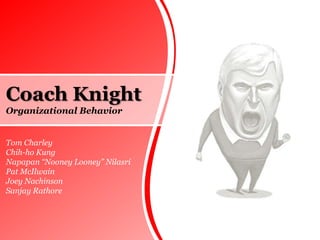
Organization Behavior Presentation (Leadership/Motivation)
- 1. Coach Knight Organizational Behavior Tom Charley Chih-ho Kung Napapan “Nooney Looney” Nilasri Pat McIlwain Joey Nachinson Sanjay Rathore
- 2. Executive Summary Background Leadership Style Motivational Concepts Comparisons Corporate Fit Ends / Means
- 7. 1997 - Video of Knight choking a player
- 8. 2000 - Fired for violation a “Zero tolerance” policy at Indiana
- 10. Isiah Thomas - Indiana Pacers, New York Knicks
- 12. Sights & Sounds
- 14. Do the ends justify the means?
- 15. Would he have been as successful with another style?
- 17. What can we learn from an old, disgruntled basketball coach?Leadership Style!
- 18. Emotional Intelligence Motivation (High) Self Regulation (Low) Self Awareness (High) Emotional Intelligence Social Skill (Low) Empathy (Low)
- 22. Employee-centered (participative/delegative)Authoritarian Participative Delegative Leader Leader Leader Employee Employee Employee
- 23. Situational Characteristics Position Power (High) Task Structure (High) Leader – Member Relationship (medium)
- 28. Fair Reward and Punishment system
- 30. Less flexibility
- 32. Hierarchy
- 33. Less emotion toward the controversial issues
- 35. The Effects on Companies What reactions might they have ???
- 42. Focus on building interpersonal relationship
- 43. Delegates authority to subordinatesVs. Consideration Factor – Friendliness, build trust/respect, strong relationships Job -Centered Behavior emphasizes employee tasks and the methods used to accomplish them Schultz Employee-Centered Behavior emphasizes employees’ personal needs and the development of interpersonal relationships Knight
- 45. Task oriented manager is autocratic
- 46. High concern for production and low concern for people
- 48. High concern for both production people
- 49. Encourages team work and commitment among subordinates, power is delegatedResults: Team environment in which motivation is based on trust and respect, leading to a high degree of satisfaction Howard Shultz Coach Knight
- 51. Leaders “imagine” their least desirable subordinate
- 52. Then rate this person numerically according the adjectiveExample of questions on LPC questionnaire Negative Terms Positive Terms Low Ratings High Ratings Low LPC Score High LPC Score Relationship-oriented Leader Task-oriented Leader
- 54. When pressured, work harder than previously
- 55. Demand greater member participation
- 57. Leader makes social adjustments (tolerance)
- 59. Leader Behavior & Situational Factors
- 61. Supportive - Friendliness, concern for subordinates
- 62. Achievement oriented - Setting goals
- 63. Participative - Sharing information, consulting
- 65. Ends / Means Do the ends justify the means? Texas Tech Indiana
- 66. ? Questions
Notes de l'éditeur
- (172)Self awareness – understand how the feelings, beliefs, and behaviors affect themselves and others (High)Self regulation – the ability to control one’s emotion (Low)Motivation – need for achievement (High)Empathy – thoughtfully considering others’ feelings when making decisions and weighting those feelings appropriately (Low)Social skill – the ability to build the effective relationships with the goal of moving people towards a desired outcome (Low)
- (233)Type A – competitive, aggressive, impatient - Push themselves to achieve higher and higher goals until they become frustrated, irritated, anxious, and hostile
- (258)Drive – amount of ambition, persistence, tenacity, and initiative that people possess.Motivation –the person’s desire to lead, influence others, assume responsibility and gain power.Integrity – maintain consistency between what they say and what they do. Gain trust from followersSelf Confidence – confident in their actions and shows that confidence to othersCognitive ability – able to process complex info and deal with changing environmentKnowledge with the domain – allows leaders to make better decision, anticipate future problems, and understand the implication of their actions
- (262)Job centered – the leader emphasizes employee tasks in a method used to accomplish themEmployee centered – the leader emphasizes employee’s personal needs and the development of interpersonal relationship
- Leader – member relationship – the degree to which a leader is respected and accepted as a leader and has friendly interpersonal relationTask structure – the degree to which tasks can be broken down into easily understood stepsPosition power – the degree to which a leader can reward, punish, promote, or demote individuals in the unit or organization(264)
- Path goal leadership theory – leader’s effectiveness depends on the degree to which a leader enhances a performance, expectancy and valences of his subordinates 267
- Directive leader (267) – behavior which is characterized by implementing guidelines, providing information on what is expected, setting definite performance standard, and ensuring individuals follow the rulesNegative reinforcement (112)– a behavior which is followed by the withdraw of the previously encountered negative consequence, thereby increasing the likelihood of that behavior will be repeated in the same or similar circumstancePunishment – a behavior is followed by a negative consequence thereby removing the likelihood of that behavior will be repeated in the same or similar circumstance
- Locus of control - degree to which an individual attributes control of events to self or external factors (High)Authoritarianism -degree to which individual believes in conventional values, obedient to authority, and legitimacy of powers, differences in society.(High)Self-monitoring:-degree to which individual attempts ot present an image he or she thinks others want to see in a given situation (Achievement motivation - degree to which an individual desires to perform in terms of excellence or to succeed in competitive situation (High)Approval motivation-degree to which an individual is concerned about presenting self in a socially desirable way in an evaluative situation (Low)